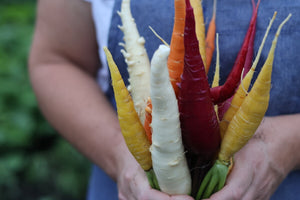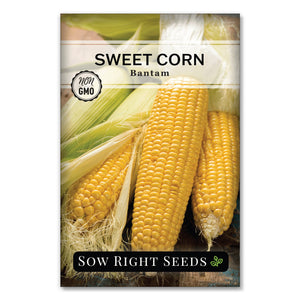How to Plant and Grow Tender Sweet Corn in Your Home Garden
CornWhy grow your own sweet corn? Because it tastes so much better! The main reason homegrown corn tastes sweeter is because of how rapidly the sugar in corn turns into starch. We’ll cover when and how to sow corn, as well as the vital tips to ensure you harvest juicy, sweet kernels!

Home Gardener’s Guide to Growing Sweet Corn
Corn used to be a staple in every home garden. Now with smaller home gardens, many think they don't have room. But these sweet corn growing tips will show you how.
The best time to plant corn is in the summer. Corn is a warm-weather crop and loves those hot summer days. Wait until the weather as warmed up before planting corn. Plan on growing corn during your hottest weather. Starting it too early in spring will only bring heartache and regret. The soil needs to be warm enough for germination. Otherwise, the seeds may just rot.
Heirloom Bantam Sweet Corn
Bantam Sweet Corn is the reliable heirloom corn. Non-GMO, open-pollinated, it has been enjoyed for generations and will give you that fresh garden-grown corn flavor you're looking for.
How to plant sweet corn from seed
The best way to plant sweet corn is to direct sow into the garden when soil temperatures are above 60ºF. (This might be the time to invest in a soil thermometer.)
Plant 2 or 3 corn seeds 1 inch deep in warm soil. (Above 60ºF)
Place a floating row cover over newly planted corn to prevent birds and other animals from digging up seeds.
Space seeds 6 to 8 inches apart in rows that are 24 to 30 inches.
Keep corn seeds moist, and they will germinate in 7 to 14 days.
Note: Although it takes more effort, you can start corn indoors. This may be necessary in areas where critters eat your seeds before they can germinate. Start seeds 3 to 4 weeks before you plan to place seedlings outdoors. Transplant corn seedlings around 10 to 14 days after they have sprouted, before they become root bound.

The Best Way to Grow Sweet Corn
These tips will ensure a healthy crop of sweet and tender corn.
Soil
Corn needs fertile, well-draining soil. In hot areas, clay soil can be beneficial as it holds on to water longer. Test soil before planting corn to see if amendments are needed. A soil pH of 6 to 6.8 is optimal.
Sun
Warmth and sunshine create the best growing conditions for sweet corn. Plant corn in an area where it will receive at least 6 to 8 hours of direct sunlight daily. It can take the heat as long as it stays watered.
Watering
Consistent water is vital for well developed ears of corn. One to two inches of water are needed each week, especially when the silks emerge. This is the time that the kernels are developing. Ensure the water is sinking into the soil, as the roots will go where the water is. Don’t let the soil dry out completely between watering.
Fertilizing
Phosphorus and potassium are essential nutrients for corn. Testing your soil before planting will determine if additional fertilizer is needed. Usually, a balanced fertilizer (NPK ratio) can be applied when the corn is starting to produce silks.
Spacing
Space corn plants 6 to 8 inches apart. Corn grown too close together will result in smaller plants and small ears of corn. Plant corn in blocks of 3 to 6 rows. Spacing is crucial for size as well as pollination.

Pollination
Getting perfect pollination is essential for well developed kernels of corn. Each corn kernel has a silk attached to it. The kernel will only develop if the pollen lands on that specific silk. On the top of each stalk of corn is a tassel. This is where the pollen is produced. Pollination happens when the wind carries the pollen from the tassel to the silks growing out of the husk on each ear of corn. Pollen can drop straight down or blow up to ½ a mile away.
When you see all those silks emerging from the husk, it may seem daunting to get all those silks pollinated. But each tassel will produce millions of pollen grains. The tassels shoot out in all directions, allowing them to drop pollen on anything below. The silks also spread out and tangle every which way so they can collect pollen blowing in from any direction. They are also slightly sticky with microscopic hairs, so pollen will easily attach.
Planting corn in groups contributes to more successful pollination since the pollen doesn’t always fall straight down onto the ears. You can also take matters into your own hands to guarantee pollination.
How to hand pollinate corn:
When the tassel is full of pollen, shake the plant and watch the pollen fall onto the silks. You can also gently cut off a tassel branch and brush it across the silks. A piece of paper is another way to catch the pollen and then pour it onto the silks. In test fields, they use paper bags to catch the pollen and then pour it onto the silks. Hand pollinating can occur within ten days of the silks emerging and continue for several days as the tassels produce more pollen.
Weeding
Be careful when weeding so that you don’t disturb the shallow roots. When corn plants are young, weeds can easily overtake them. Once the corn stalks are tall, they will shade out weeds. We found these tools to be the most helpful for weeding.
Crop Rotation
Rotating your crops can help prevent soil problems. Put in cover crops after harvesting corn. Nitrogen-fixing cover crops will replenish the soil for the next planting.
Companion Planting
Companion planting is an excellent way to maximize your garden space and benefit your plants. Traditional companion plants for corn are beans and squash. This trio is known as The Three Sisters. Click here to read all the details of growing corn with the Three Sisters Method.

Harvesting Sweet Corn
Ahhh, the sweet, delicious harvest. The perfect harvesting stage is called the “milk stage.” The kernels are nice and plump and full of juicy goodness. The corn silks will turn brown and start to dry. At this stage, the ear of corn should feel full.
If you’re not sure by looking at the silks and feeling the ear, you can check the kernels. Gently peel back the husk and take a peek. If you poke a kernel with your fingernail, it should burst with milky juice. If it is clear, they need more time. Put the husk back in place and wait a few more days.
It can take anywhere from 15 to 24 days for kernels to fully ripen from when the silks appear. Of course, the kernels have to have been pollinated.
Each stalk of corn will only have 2 or 3 ears. Pick corn in the morning while the ears are still cool. You don’t have to harvest them all at once. To remove an ear of corn, pull down and twist.
Sweet corn will start turning into starch after it has been harvested. Heat will accelerate that process. Place harvested ears of corn in the refrigerator and plan to eat them as soon as possible for the sweetest flavor.
Drying Corn
If you want to use your corn for popcorn or cornmeal, allow it to fully mature and dry before harvesting. The Blue Hopi corn is excellent for using as corn flour. The Strawberry corn makes a beautiful ornamental or popping corn.
Sweet Corn FAQs
How many ears of corn are on each plant?
One to 3 ears of corn will grow on each plant.
How long does sweet corn take to grow?
Depending on the variety, it can take 60 to 100 days from seed to harvest.
Why don’t I have any kernels on my corn?
Pollination is the culprit for undeveloped kernels. Each kernel needs to be pollinated in order to develop into an edible harvest.
How do I know when sweet corn is ready to pick?
Corn is ready to harvest when the ear of corn feels “full” to the touch, and the silks are brown and drying up.
Is corn a genetically modified food?
Heirloom corn is non-GMO. Our open-pollinated corn has been enjoyed for generations.
You can enjoy the sweetest corn when you grow it in your own garden. With these tips on watering, pollinating, and harvesting, you have the knowledge you need to be successful. Try a patch of sweet corn in your garden.
Written by Beverly Laudie








Leave a comment